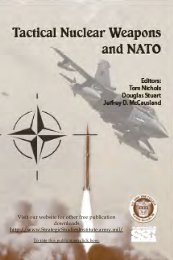Revisiting the Dove's Dilemma: - Program on Strategic Stability ...
Revisiting the Dove's Dilemma: - Program on Strategic Stability ...
Revisiting the Dove's Dilemma: - Program on Strategic Stability ...
You also want an ePaper? Increase the reach of your titles
YUMPU automatically turns print PDFs into web optimized ePapers that Google loves.
Ericks<strong>on</strong> and Way, “Doves <str<strong>on</strong>g>Dilemma</str<strong>on</strong>g>”<br />
reported in columns 3 and 4. As <str<strong>on</strong>g>the</str<strong>on</strong>g> results show, all exporters resp<strong>on</strong>d roughly <str<strong>on</strong>g>the</str<strong>on</strong>g> same way to<br />
<str<strong>on</strong>g>the</str<strong>on</strong>g> pursuit of nuclear weap<strong>on</strong>s, except for <str<strong>on</strong>g>the</str<strong>on</strong>g> United States. On average, according to <str<strong>on</strong>g>the</str<strong>on</strong>g> model<br />
in column 1, an exporter-importer dyad features about 33% more arms flows (<str<strong>on</strong>g>the</str<strong>on</strong>g> average figure<br />
is higher when we separate out <str<strong>on</strong>g>the</str<strong>on</strong>g> atypical behavior of <str<strong>on</strong>g>the</str<strong>on</strong>g> USA) when <str<strong>on</strong>g>the</str<strong>on</strong>g> importer is pursuing<br />
nuclear weap<strong>on</strong>s. However, as <str<strong>on</strong>g>the</str<strong>on</strong>g> model in column 2 shows, for <str<strong>on</strong>g>the</str<strong>on</strong>g> United States <str<strong>on</strong>g>the</str<strong>on</strong>g>re is no<br />
discernable increase. In fact, <str<strong>on</strong>g>the</str<strong>on</strong>g> USA-specific coefficient is negative (indicating a roughly 30%<br />
drop in arms flows), although not discernable from zero.<br />
Our data analysis spans over 40 years – and a lot can change in four decades. The nuclear<br />
n<strong>on</strong>-proliferati<strong>on</strong> regime emerged, <str<strong>on</strong>g>the</str<strong>on</strong>g> first Gulf War revealed <str<strong>on</strong>g>the</str<strong>on</strong>g> porousness of <str<strong>on</strong>g>the</str<strong>on</strong>g> NPT regime,<br />
<str<strong>on</strong>g>the</str<strong>on</strong>g> ideati<strong>on</strong>al climate regarding nuclear weap<strong>on</strong>s changed, and states had plenty of time to learn<br />
what works – and what doesn’t. Thus it is very possible that <str<strong>on</strong>g>the</str<strong>on</strong>g> relati<strong>on</strong>ship between our<br />
variable of interest and <str<strong>on</strong>g>the</str<strong>on</strong>g> outcome of interest changes over time. To explore this possibility, we<br />
estimated moving windows versi<strong>on</strong>s of both <str<strong>on</strong>g>the</str<strong>on</strong>g> total import and dyadic models. By estimating<br />
<str<strong>on</strong>g>the</str<strong>on</strong>g> model sequentially for rolling slices of time, this procedure allows us to see if <str<strong>on</strong>g>the</str<strong>on</strong>g> coefficient<br />
<strong>on</strong> <str<strong>on</strong>g>the</str<strong>on</strong>g> variable of interest changes over time.<br />
Starting with <str<strong>on</strong>g>the</str<strong>on</strong>g> models for total imports, Figure 2 reports <str<strong>on</strong>g>the</str<strong>on</strong>g> coefficient <strong>on</strong> pursuit of<br />
nuclear weap<strong>on</strong>s from a moving windows versi<strong>on</strong> of <str<strong>on</strong>g>the</str<strong>on</strong>g> model reported in column 1 of Table 1.<br />
(note: moving windows results not ready yet; <str<strong>on</strong>g>the</str<strong>on</strong>g>se are an approximati<strong>on</strong> using period dummies).<br />
The relati<strong>on</strong>ship between <str<strong>on</strong>g>the</str<strong>on</strong>g> pursuit of nuclear weap<strong>on</strong>s and access to c<strong>on</strong>venti<strong>on</strong>al arms clearly<br />
changes over time. Both before <str<strong>on</strong>g>the</str<strong>on</strong>g> era of <str<strong>on</strong>g>the</str<strong>on</strong>g> n<strong>on</strong>-proliferati<strong>on</strong> regime – roughly from 1969<br />
<strong>on</strong>wards – and after <str<strong>on</strong>g>the</str<strong>on</strong>g> end of <str<strong>on</strong>g>the</str<strong>on</strong>g> Cold War <str<strong>on</strong>g>the</str<strong>on</strong>g>re is no discernable relati<strong>on</strong>ship between pursuit<br />
of nuclear arms and total imports of c<strong>on</strong>venti<strong>on</strong>al weap<strong>on</strong>s. We cannot reject <str<strong>on</strong>g>the</str<strong>on</strong>g> hypo<str<strong>on</strong>g>the</str<strong>on</strong>g>sis that<br />
pursuing nuclear weap<strong>on</strong>s makes no difference for total imports of arms. However during <str<strong>on</strong>g>the</str<strong>on</strong>g><br />
20








